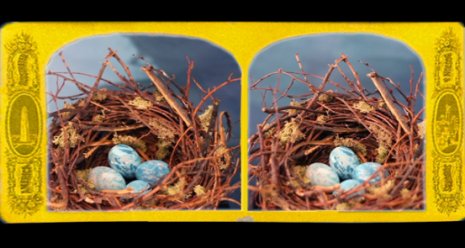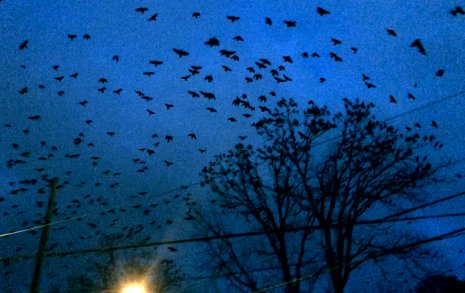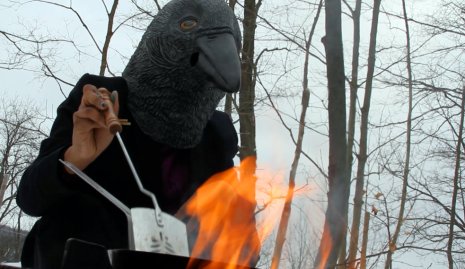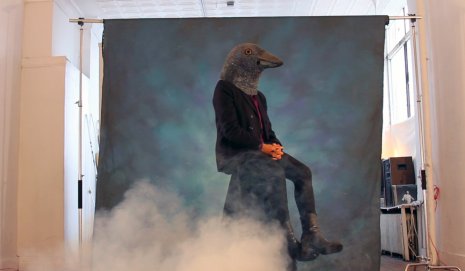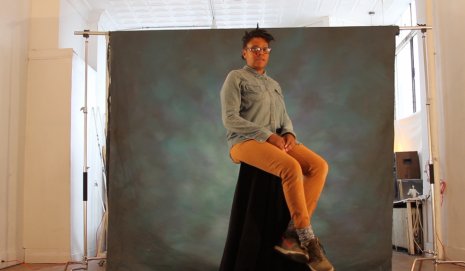Chapter Two
RC:
I see that in the work. Sometimes I’m taken by a heightened color, other moments are about an amazing score or musical refrain, in other instances there is a beautiful gesture. But ironically the thread of beauty leads me back to the issue of narrative and the trap of its salaciousness. One way to interpret the more ambiguous relation to narrative in your work is through the lens of the poetic. Are the films poems in any way? Or, perhaps it is a sense of magic? Do either of these, as ways of out pacing, or moving beyond, narrative resonate with you?
I ask because in foregoing narrative perhaps you realize some other maneuvers that speak as resolutely to spectator needs and desires?
CS:
Poetry and magic, yes! In the autodidactic world of my studio and editing bay I can safely say that poets and musicians are my teachers. I listen to poets read their work. I listen to musicians play their ideas. Both disciplines interrogate structure— investigate form. And I do sometimes use objects and images for their symbolic and associative powers. I actually have an index of things that constantly circulate in my work: ivory soap, pyramids, our Milky Way, tuning forks, sea shells, flower arrangements, small brightly painted buildings (schools, municipal buildings), birds, disco balls, repeating patterns like wallpapers, rocks, potted plants, rainbows, vacant lots…
Powers…! My friend, AJ (Arthur Jafa), blew my mind just the other day speculating on the way in which the world perceived blackness versus the actual experience of being a human being whose skin is black. He talked about our (black folks’) general waking state as being one of deep contemplation and hypersensitive observation. But we are rarely seen/depicted this way because when attention is turned to us, usually, we are being scrutinized, or under duress; and so our way of surviving, escaping, managing theses pressures is through glamours - by making magic, casting spells, performative feats of liberation.
Remember that scene in 12 Years A Slave where Chiwetel Ejiofor is just silently contemplating his reality? I don’t now how long that shot on his face lasted but for me that cinematic moment wordlessly articulated the deep eternity of black diasporial consciousness. “Who am I, how is it possible that I am here, like this? What is this life for? How do I live it? What is this pain?” Oh so many questions we could project onto Mr. Ejiofor’s face in that wordless (though sound-rich) moment. I cannot recall seeing that before— black people rendered as silently introspective, investigating ourselves and our interior galaxies. I learned something from the experience of seeing that. Learned about my own desire to see and render these kinds of inner-spaces. The last time I made something explicitly pointing to that inner space was, ironically, a narrative! (Drylongso, 1998). This is now something that I am looking towards in my work. Sorry, I’m talking about work I haven’t made yet, Future Glamours. Wow, that seems like an apt title for what I’m working on right now!
I recognize this fascination with glamours, spells, and performative potions in my own work, (Crow Requiem, 2014, Spin, 2012, Entitled, 2006.) Surely this helps explain my indebtedness to the strategies of science fiction as well. I am comfortable thinking of myself as participating in this feedback loop of projected image-making/illusion-making and that which is perceived and made whole through our desires. I enjoy watching folks perform glamours, even while understanding that the illusion prevents me from accessing a contemplative interior space. Watching Chicago teenage girls dance together is like having a magic spell cast upon you. I so value this power even while feeling the urgency of slowing the trick down so that we see beyond the girls’ power into their vulnerability, bonds, fears, and wishes.
But then, how do we articulate those desires? Poetry becomes necessary. The precision with which words can be deployed to describe the deep inner spaces blows my mind. The command of pace and aural texture in poetry is very instructive, and the concentration and density of imagery is something I give myself permission to do because I see it happening in poetry.
I think the fun thing about image making is the relationship between the word and the image. Semiotics, right? How does one inform and shape the other? How can we expand or collapse meaning by combining word and image? These are rather urgent questions in my studio right now. What happens when the word does not tell, but rather augments what the image shows? Maybe this is because my training in this craft is so remedial, but with poetry I feel like it’s good to go slow. The modulation of pace in filmwork is something I wish I were more sensitive to. Lately I’ve been moving very fast so that the only way to digest all of the symbols is through repeated viewings. I need to learn from what poetry does, from the space between words between breath. In film, breath is hard to manifest.
LaTasha N. Nevada Diggs’ book TwERK is currently teaching me about mixing tongues and reminding me about the power of a splice. Interject another strategy into the poetry+magic equation and I think you get collage. I do a lot of cutting, pasting, and mashing up. I used to think of it as being akin to sampling, in hip hop. I also recognize collage, from Max Ernst and Hannah Hoch to Wangechi Mutu and Krista Franklin as being crucial to the way in which I draw archival materials, and sci-fi and horror films into the palette from which my images and sound will be pulled. Close Encounters of the Third Kind (my favorite Spielberg film for sure!) and John Carpenter’s The Fog are two recent examples of direct samples/bytes from movies. And of course I am currently elbow deep in Octavia Butler’s archives. This after spending 2 years rummaging through the audiotapes and ephemera of Sun Ra.
It’s a bit irreverent and frequently oblique (and my references certainly betray my Gen-X origins) but maybe using material from popular movies has something to do with the spell-casting as well. I am dedicated to the quotidian and the potential magic one can encounter in the mundane with just a little tweaking of perspective. According to the great science-fiction literary theorist, Darko Suvin, this augmentation action I'm calling tweaking should be called The Novum. It’s the device used to indicate that what a reader/viewer is encountering is not of the world to which they are accustomed even though the actions or interior monologs described are wholly familiar. You know that movie Yeelen by Souleymane Cissé? A King tells the sorcerer his problem and the sorcerer says he can fix it. He issues his requirements for materials/ingredients for the spell. He combines these things in some procedural way and produces a result that satisfies the King. You can tell he’s done this many times before. Magic? Science? Poetry? Performance?…All of the above.
RC:
Yes, all of the fore-mentioned and so much more. The project of making for you is wonderfully inclusive and additive. It takes on more and more—of your questions, concerns, interests. There is a density of references and researched elements (not in a merely academic sense). And yet, the exposition, the way that these ideas live with you; the way that you dwell upon them (as it seems) over time and through your encounters and experiences is intriguing, refreshing.
This feels like going for a walk with you! And that we’re encountering the ideas that are meaningful to you, in an almost physical sense, along the way. So, the last question (for now) has to do with how others join in with you as a maker and thinker (AJ, Spielberg, Sun Ra, etc.). What are the stakes of community and collaboration for you?
CS:
I’ve been rolling this question around for a couple of days now, Romi! It seemed like such a simple question at first, but it triggered all manner of urgent inquiries within me. I found myself wanting to just make a list of people, places and things in the past present and future that are helping me formulate my new work and understand past works:
Zora Neal Hurston, Sun Ra, Octavia Butler, Alice Coltrane, Shakers Mother Ann Lee and Sister Rebecca Jackson, Joe McPhee, Senga Nengudi, Simon Rodia, Henry Darger, Mike Kelley, Paul Chan, Derrida, Sylvia Wynter, Dan Graham, N.K. Jemisin, Vlisco, Audre Lorde, Renee Greene, Eldzier Cortor, Maya Deren, Samuel Delany, Rammellzee, Augusta Savage, Elizabeth Catlett, Joseph Yoakum, Kerry James Marshall, Mary Lou Williams, Trinh T. Minh Ha, Angela Davis, Lynn Hershman-Leeson, Hortense Spillers, Sister Rosetta Tharpe, Egunguns, Fred Moten, Paul Pfieffer, James Baldwin, Herb Kent, Ruth Asawa, Drexciya, Dutch wax prints, Derrick May, the Los Angeles River, Shaker Communes, Fried Fish shops, vinyl records and cassette tapes, Ikea Textiles, CCTV cameras, Dazzle, gay pride flag, fog, Crows, Suiseki, Elephants, Cats, The Rift Valley, Vacant Lots, EL train, bicycles —- I’ll stop there.
And of course there are my contemporaries, co-conspirators, my brothers and sisters in crime. I wanted to talk about my resistance to the very idea of collaboration. That when I work with other artists, or non-artists, or invade spaces and places in the interest of making images, I think of these exchanges as conspiratorial. The root word, there conspire, means to breathe together. Of course the notion of the fugitive, is something I’m biting from Mr. Moten.
It’s been helpful to understand the way in which certain kinds of gestures, spaces and alliances are so resistant to hegemony that they can only exist in the shadows, and sometimes sanctioned for it, sometimes rewarded. You know when I stumbled on John Carpenter’s film, The Fog -- it was on one of those free digital channels (too cheap to pay for cable) -- and I just wanted some chatter on in the background, but I was transfixed. Not only was the narrative a breath of fresh air, so libertine compared to our contemporary age, but the wily low-budget aesthetics were really gorgeous to me, and the politics were making smart distinctions between social morals and fundamental ethics. Wonderful! I felt like I was watching a movie that was really made with love for its audience and for the craft itself. To me that’s so honorable and I learn from it. When making something, regardless of the opinion of people who make decisions around value, make it as attentively and as lovingly as you can.
There is also the very necessary act of quoting, and repeating. One of my favorite uses of “the quote” happens in “free jazz” also known as creative music. Lester Bowie loved doo-wop music. He would use its friendly melodies and tight structure for all manner of conceptual inquiry. Take a song like The Great Pretender. Mr. Bowie would take this tune so far out as to lead you to associations that are totally free of the melody and its lyrics, but then he reels you right back into the pocket and rocks that melody it like a cradle. “The Quote” grounds and roots; creates a lineage between one maker and another, one world and another. It's best deployed through repetition (like the structure of a pop song) because in this way, through time, our understanding of the text, image, sound deepens and becomes more complex. Like a griot who composes history into rhyme as it happens but also holds within herself all the histories of her ancestors at the ready for recitation. How does one remember 10,000 years of history? Through repetition, through rhyming, through echoes, through quotes, perhaps. Part of my making process involves performing this same honor to my intellectual antecedents, my contemporary teachers.
Then I wondered if what you are asking is, “Who am I talking to and who is talking to me?” To which I wanted to answer, that I am talking to the future-me’s and I am talking to those in the past (and present) who made me. Recently I had a screening at an academic institution, and a very venerable film scholar and critic was kind enough to host the evening. Once the work had screened, (The Way Out Is The Way Two, 2012), she did her best to comment on the film but was really, I suspect, frustrated by the work. I offered up that I’m not really making movies anymore and on that point she enthusiastically agreed. I’m using time-based media, but my forms, tactics, strategies, and sometimes even content, fails to honor the medium in which I’m working.
Sometimes when I’m listening to a symphony, I wonder what it would be like to listen to that same composer improvise on their chosen instrument. How would they betray the etiquette and structure of a symphony when just playing and listening to themselves or perhaps other improvisers? (This is why we need time-travel, stat!) I’m often encouraged by friends to make “real movies” to return to that form. You know, write a script, get a producer, cast actors, hire up a lot of crew and tell some kind of story. I would compare this notion of a real movie with a symphony: A highly structured form that is already understood by the listener/viewer. We know when it will go fast, we know when it will go slow. Be loud, go low—we know all this before the symphony drops the first note, before the projector lamp lights up. Surely there can be another way to commune with moving images. It is well understood that in music that there are other ways of organizing sound - as far back as Paganini, right (Oh well, earlier and on a different continent of course!)? With narrative comes attachment (to characters) and judgment, I’m not sure I trust myself to hand these things out. Narrative films are like sermons. They promise to deliver ecstasy and redemption; they promise to satiate (or at least re-direct) desire. By failing to work in this way, by failing to “make movies” I seem to be refusing the spectator a lot of things she may want, but I am also offering something else hopefully, like tools that allow for self-reflection while simultaneously pointing to the ways in which we are so intimately connected. Not through emotional triggers, but through a confrontation with one’s own experience in relation to what is being shown. Lots of artists try to break open The Movie; I’m not alone here. It wasn’t deliberate, walking away from Cinema or Narrative. It’s just what came out of experimenting, with imitating musical structures, pushing against poetic structures, and really just mining whatever material I am able to gather.
My little films, I understand better now, are that space in between the glamours! Pleasure will not be derived from delicately executed mise-en-scene in service to narrative. Desire is not excited in the affective reward of a satisfactory emotional journey. The places in which thought occurs, stillness is centered, glimpses of those illusive interior spaces are caught — that’s where the videos live and that’s why they so actively, quote and homage my teachers, my friends.
Culture is all the stuff we make of our dreams and desires, all the ways that we deal with our troubles and worries. Culture isn’t something that can be hierarchically valued and arranged, not really. Time erodes these kinds of values systems and distance allows us to see the folly in that strategy. There is the thing we gaze upon, the experience we vicariously consume, the sociological phenomenon we approach. The magic we make for each other out of whatever we can find around us. There is that.
""When making something, regardless of the opinion of people who make decisions around value, make it as attentively and as lovingly as you can.""


